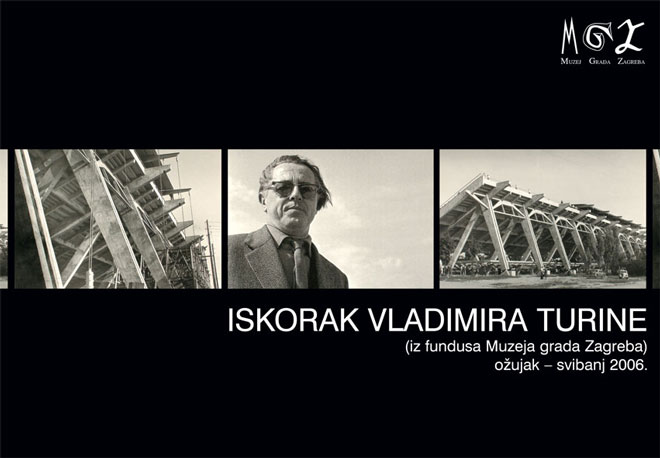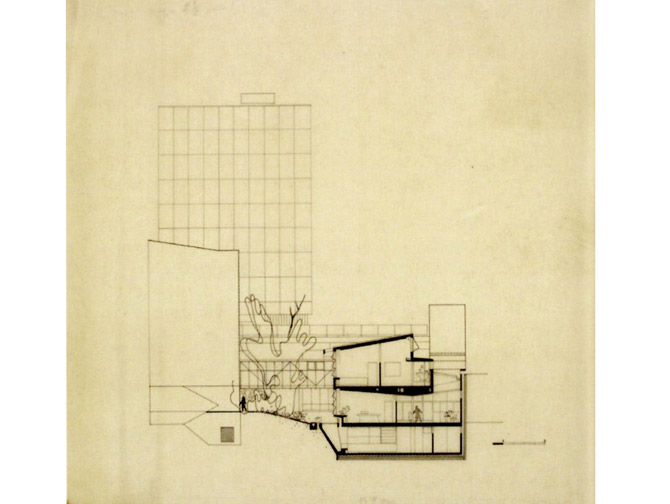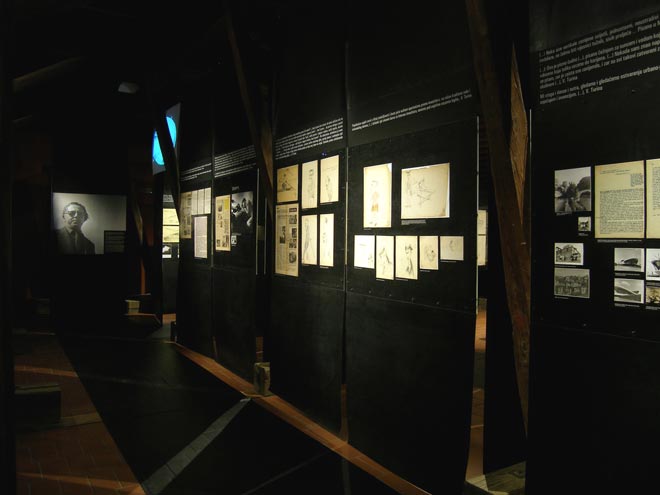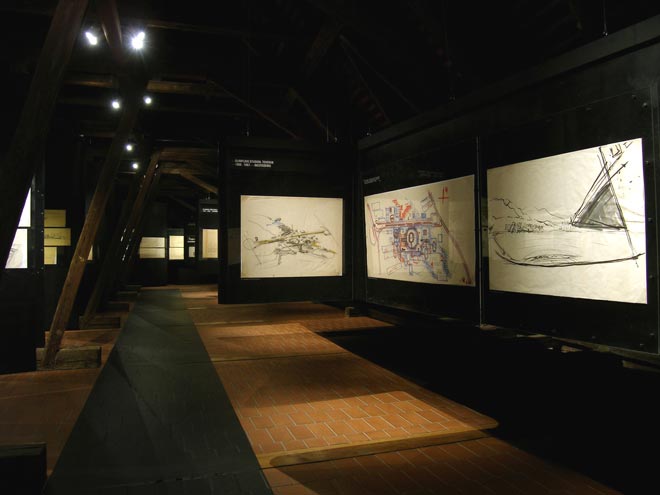The Breakthrough of Vladimir Turina (from the holdings of Zagreb City Museum)
Exhibition concept: Hela Vukadin-Doronjga, MSc
Exhibition design: Bilić_Müller Design Studio
Poster design: Kruno Vlahović

Emotion, expression, intensity, spiritual dimension, these are all crucial for interpreting the architect Vladimir Turina's entire work. The avant-garde challenge that arises from his intense lifestyle and work imposed itself as dominant throughout the course of the research.
The temporal frameworks in which we follow and observe his works are the 1940s, 1950s and 1960s ... totalitarianisms (fascism, communism) – the appearance of different, yet in essence in their exclusivity, similar systems that were escalated by the war. In general, this was a time of distrust, insecurity and uncertainty ... A feeling of isolation prevailed. All this had a deep impact on sensitive Turina. He was not politically active – the Party did not consider him to be serious enough – they thought that he was not capable of realizing Party tasks, which was in large part brought about by his nonconformism, his breakthrough attitude. In that way he confirmed himself as a real representative of the avant-garde. Turina had a mind of his own, meaning that he did not consent to numerous compromises. In his texts Turina demystified society, laughing at hypocrisy, sanctimoniousness, mediocrity, posturing, and lies ...
The presentational criterion of this exhibition was not to show all his works, but only the paradigmatic ones – those which reveal Turina's creative signature and which he is known by. For this reason emphasis was given to constructivism and graphism which mostly influenced his students. The literary component was added as well, which imposed itself with its relevance during the course of the research. It was necessary to present Turina with the help of those elements that he himself inaugurated. Constructivism here is the refined constructivism of the aesthetics of concrete – Maillart's, Nervi's, Niemeyer's aesthetics – this was his lifelong dream. Graphism or literature here means the explosion of graphism / graphic expression / syntax / words. As a representative of the post-war existentialism, Turina is turned to himself, to the man-individual. This is how his texts are intoned, regardless of whether they are scientific-theoretical or of a private nature. This is how his sketches are (sections, ground-floor plans) with their ever-present people in motion, carrying their worries and problems. This is precisely what he aspired to in architecture, which he considered a creative area, very much connected to man and to the level of his consciousness ... connected to man and the individual.
The first level of the presentation encompasses five compact units which are the contextual starting point and basis for understanding the scope and significance of Vladimir Turina's (Banja Luka, 1913 – Zagreb, 1968) entire opus – associate professor, planner, builder, critic and theoretician of architecture and city planning, master of graphic expression, excellent educator, lucid man of letters. Here the emphasis is given to his literary material and to emotions. Thus the first group of exhibits consists of unpublished manuscripts and correspondence originating from the period between 1942 and 1944. On the run from his everyday war life, Turina turned to translating.
The positive and negative sides of the fifties and sixties, along with many problems from the field of architecture and city planning, still actual today, can best be read through Turina's rich bibliography (especially from the 1960s when he published a series of articles in the weekly Telegram on the topic of humane ambiences in contemporary city planning and architecture). The exhibition presented the key texts, actual even today, which stimulate us to contemplation – where are we today?
Just as in his texts, in his architecture Turina subjects spatial dynamics, the possibility of transformation and the method of contrast to both content and emotion (Centre for the Protection of Mother and Child, Zagreb). Turina at the same time masterfully resolves the demanding construcion tasks of stadium building (the Dinamo Stadium in Zagreb).

Centre for the Protection of Mother and Child, Zagreb, Klaić Street 16, 1953-1956

Dinamo Stadium, Zagreb, Maksimir (Vladimir Turina, Eugen Erlich, Franjo Neidhardt), 1946-1962
An especially important role at the exhibition was assigned to the sound setting, which was not selected exclusively according to the criteria of the time in which Turina lived and created. The selection criterion was Turina's modus vivendi (spirit, temperament – intense lifestyle, his destiny of coming out). All these emotions were amplified at the exhibition with the music selection, which linked hallucinogenic rhytms, primordial garage sounds (garage rock) and punk, and which – through individual expressions, connect the feeling of isolation, non-conformism, and crossing over and walking "on the other side".
Turina's quality – moral (self-examination, quest for the good and positive) and intellectual superiority – coming out (opposing posturing, compromising attitude and mediocrity) – resulted in nevertheless a smaller number of realizations, because many, being envious of him, refused to help. Sensitive to ignorance and injustice, he accumulated these within himself, and that certainly contributed to his premature death.
Hela Vukadin-Doronjga
Pictures from the exhibition






photo Miljenko Gregl, ZCM
 Exhibition catalogue
Exhibition catalogue
Vukadin-Doronjga, Hela. The breakthrough of Vladimir Turina (from the holdings of Zagreb City Museum).
Zagreb : Zagreb City Museum, 2006

